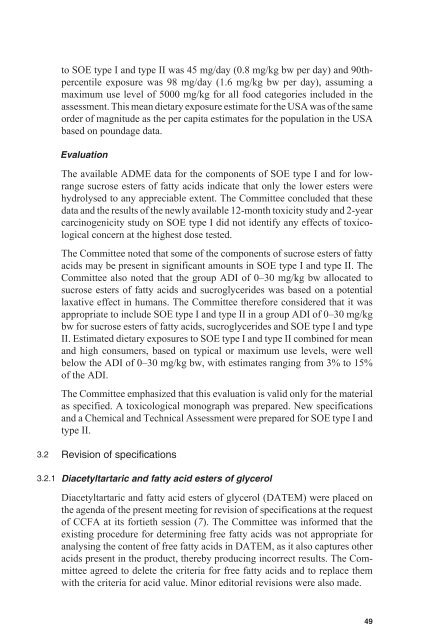evaluation of certain food additives - libdoc.who.int - World Health ...
evaluation of certain food additives - libdoc.who.int - World Health ...
evaluation of certain food additives - libdoc.who.int - World Health ...
Create successful ePaper yourself
Turn your PDF publications into a flip-book with our unique Google optimized e-Paper software.
to SOE type I and type II was 45 mg/day (0.8 mg/kg bw per day) and 90thpercentile<br />
exposure was 98 mg/day (1.6 mg/kg bw per day), assuming a<br />
maximum use level <strong>of</strong> 5000 mg/kg for all <strong>food</strong> categories included in the<br />
assessment. This mean dietary exposure estimate for the USA was <strong>of</strong> the same<br />
order <strong>of</strong> magnitude as the per capita estimates for the population in the USA<br />
based on poundage data.<br />
Evaluation<br />
The available ADME data for the components <strong>of</strong> SOE type I and for lowrange<br />
sucrose esters <strong>of</strong> fatty acids indicate that only the lower esters were<br />
hydrolysed to any appreciable extent. The Committee concluded that these<br />
data and the results <strong>of</strong> the newly available 12-month toxicity study and 2-year<br />
carcinogenicity study on SOE type I did not identify any effects <strong>of</strong> toxicological<br />
concern at the highest dose tested.<br />
The Committee noted that some <strong>of</strong> the components <strong>of</strong> sucrose esters <strong>of</strong> fatty<br />
acids may be present in significant amounts in SOE type I and type II. The<br />
Committee also noted that the group ADI <strong>of</strong> 0–30 mg/kg bw allocated to<br />
sucrose esters <strong>of</strong> fatty acids and sucroglycerides was based on a potential<br />
laxative effect in humans. The Committee therefore considered that it was<br />
appropriate to include SOE type I and type II in a group ADI <strong>of</strong> 0–30 mg/kg<br />
bw for sucrose esters <strong>of</strong> fatty acids, sucroglycerides and SOE type I and type<br />
II. Estimated dietary exposures to SOE type I and type II combined for mean<br />
and high consumers, based on typical or maximum use levels, were well<br />
below the ADI <strong>of</strong> 0–30 mg/kg bw, with estimates ranging from 3% to 15%<br />
<strong>of</strong> the ADI.<br />
The Committee emphasized that this <strong>evaluation</strong> is valid only for the material<br />
as specified. A toxicological monograph was prepared. New specifications<br />
and a Chemical and Technical Assessment were prepared for SOE type I and<br />
type II.<br />
3.2 Revision <strong>of</strong> specifications<br />
3.2.1 Diacetyltartaric and fatty acid esters <strong>of</strong> glycerol<br />
Diacetyltartaric and fatty acid esters <strong>of</strong> glycerol (DATEM) were placed on<br />
the agenda <strong>of</strong> the present meeting for revision <strong>of</strong> specifications at the request<br />
<strong>of</strong> CCFA at its fortieth session (7). The Committee was informed that the<br />
existing procedure for determining free fatty acids was not appropriate for<br />
analysing the content <strong>of</strong> free fatty acids in DATEM, as it also captures other<br />
acids present in the product, thereby producing incorrect results. The Committee<br />
agreed to delete the criteria for free fatty acids and to replace them<br />
with the criteria for acid value. Minor editorial revisions were also made.<br />
49

















